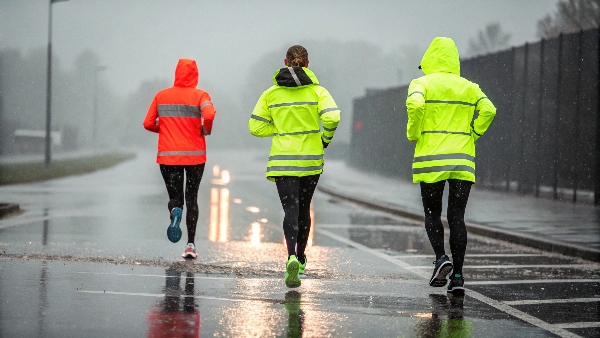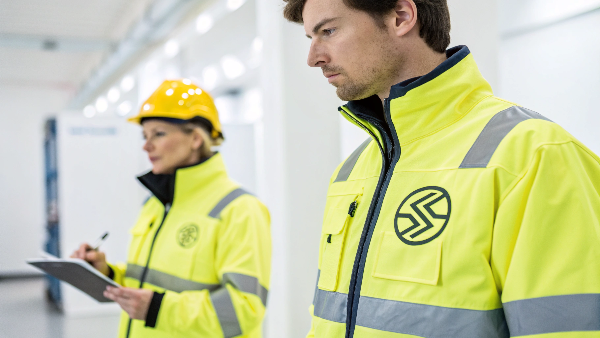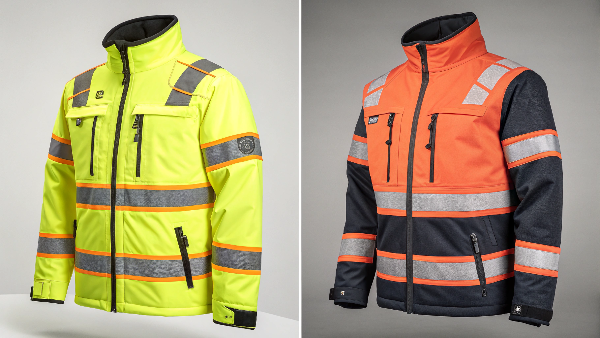Low visibility causes accidents. Imagine not being seen in dim light by a moving vehicle. A reflective vest makes you stand out, preventing tragedy.
Reflective vests are lifesavers because they use high-visibility materials and retro-reflective tape. This makes you easily seen by drivers and machinery operators, day or night, preventing serious accidents and injuries.
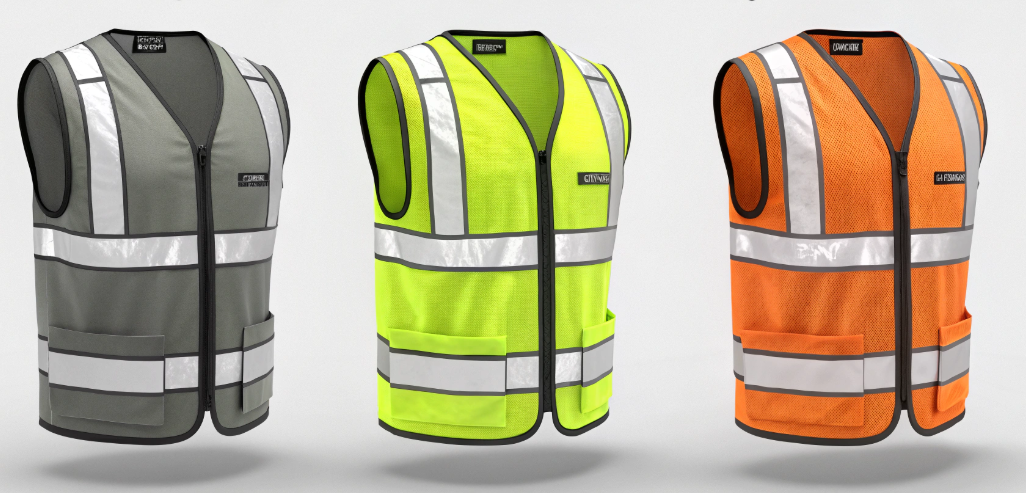
It's clear these vests are very important for safety. You might be wondering more about how they actually work. You might also want to know why they are so effective in different situations. We can look at this more closely. Let's explore this further to understand their full value.
What is the purpose of wearing a reflective vest1?
Unseen workers are at constant risk. This risk can lead to very bad, even tragic, outcomes. Reflective vests drastically increase visibility2, keeping people safer.
The main purpose of wearing a reflective vest is to make the wearer highly visible. This is especially crucial in low light, bad weather, or busy environments, reducing accident risks significantly.
[image placeholder]
The core purpose of a reflective vest is all about making a person easy to see. Human eyes need contrast to pick things out, especially when it's dim or dark. These vests use two main types of materials.
| Material Type | Primary Use | How it Works |
|---|---|---|
| Fluorescent Fabric | Daytime | Absorbs UV light, re-emits as vibrant color |
| Retro-reflective Tape | Nighttime/Low Light | Bounces light directly back to the light source |
Bright, fluorescent colors are for daytime. These colors are very vibrant and stand out against most backgrounds, like trees, buildings, or the sky. Then, there are retro-reflective tape3s. These tapes are designed for nighttime or low-light conditions. They don't glow on their own. Instead, they bounce light from sources like car headlights directly back to the source. This makes the tape appear very bright to the person near the light source, like a driver. At Vissafety, we design our vests with this primary purpose always in mind. Our goal is to make sure someone gets home safe. We think about all the different light conditions a worker might face. This commitment to the core purpose of visibility drives our design and every vest we produce.
What are the benefits of a reflective jacket?
Vests offer good visibility, but what if you need more coverage or warmth? Less coverage can mean less protection in certain outdoor situations. Reflective jackets offer enhanced benefits beyond just a vest.
Reflective jackets offer all the visibility benefits of a vest. Plus, they give added protection from weather like rain, wind, and cold. They also provide more surface area for reflective material.
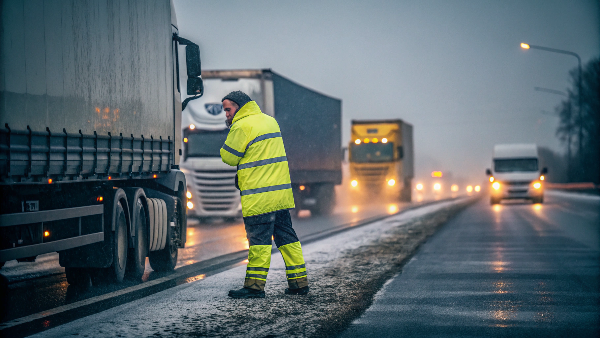
When we talk about reflective jackets4, we're looking at more than just visibility. Of course, being seen is still the main goal, just like with a vest. Jackets often have more surface area. This means we can put more fluorescent material and more reflective tape on them. This can make a person even more visible, especially from farther away or from different angles. But jackets offer other important benefits too.
| Feature Comparison | Reflective Vest | Reflective Jacket |
|---|---|---|
| Primary Benefit | High Visibility | High Visibility & Weather Protection |
| Surface Area | Standard | Larger (more reflective material possible) |
| Weather Protection | Minimal | Good (rain, wind, cold resistance) |
| Warmth | Little to None | Can provide significant warmth |
| Additional Features | Basic | Often includes pockets, hoods, etc. |
They can protect you from the weather. Many of our Vissafety reflective jackets are waterproof or water-resistant, keeping workers dry in the rain or snow. They can also provide warmth in cold conditions, sometimes with special lining. This is a big deal for workers who are outside for long hours. A worker who is comfortable and protected from the elements is usually a safer and more focused worker. We also design jackets with practical features like pockets for tools or personal items. For clients like Danny Cheng, whose customers in North America face tough winters, a reflective jacket is often a better choice than just a vest.
What are the benefits of safety vests?
Workplace hazards are everywhere. Ignoring these dangers can lead to very serious incidents and injuries. Safety vests offer crucial protection by making you seen.
Safety vests, especially reflective ones, significantly enhance worker visibility. This helps prevent accidents with vehicles or machinery. They can also indicate roles, improve compliance, and are lightweight.

The term "safety vest" itself tells you its main job: to improve safety. The most obvious benefit, especially for the vests we make at Vissafety, is increased visibility. This helps prevent accidents where a worker might not be seen by someone operating a vehicle or machinery. But there are other benefits too.
| Benefit Category | Description |
|---|---|
| Enhanced Visibility | Primary function; makes wearer stand out in various light conditions. |
| Role Identification | Different colors can signify different roles or authority levels on site. |
| Compliance | Helps meet legal and company-specific safety regulations. |
| Accident Prevention | Directly reduces risk of being struck by vehicles or machinery. |
| Lightweight Design | Generally comfortable and non-restrictive, encouraging consistent use. |
Sometimes, safety vests come in different colors. These colors can be used to identify different roles on a worksite. For example, a supervisor might wear one color, and a new worker might wear another. This helps with organization and communication, which are also parts of safety. Wearing a safety vest also helps companies meet safety regulations. Many jobs require them by law. Another benefit is that they are usually lightweight and designed not to get in the way of work. This makes it more likely that workers will actually wear them. We focus on making our vests comfortable for this exact reason. If a vest is uncomfortable, people might not use it, and then the safety benefits are lost.
Who wears reflective vests?
Are you wondering if a reflective vest is something you or your team should be using? Not knowing can leave people unprotected in risky situations. Many professions rely on them every single day.
Reflective vests are worn by construction workers5, road crews, emergency responders6, airport ground staff, cyclists, runners, and anyone needing high visibility in potentially hazardous environments.

Many different kinds of people wear reflective vests. At Vissafety, our clients come from a wide range of industries. For example, construction workers are some of the most common users. They work around heavy machinery and moving vehicles, often in complex sites.
| User Group | Primary Reason for Use | Typical Environment |
|---|---|---|
| Construction Workers | Visibility around machinery, traffic, complex sites | Building sites, infrastructure |
| Road Crews | Visibility to passing traffic | Highways, local roads |
| Emergency Responders | Visibility at accident scenes, often chaotic/low light | Accident sites, disaster areas |
| Airport Ground Staff | Visibility around aircraft and service vehicles | Airport tarmacs, runways |
| Cyclists & Runners | Visibility to vehicular traffic | Roads, paths near traffic |
| School Crossing Guards | Visibility to drivers in school zones | School zones, pedestrian crossings |
Road maintenance crews also absolutely need them because they work right next to traffic. Emergency responders, like police officers, firefighters, and paramedics, wear them at accident scenes. These scenes can be chaotic and often happen at night or in bad weather. Airport ground personnel, who work around moving planes and service vehicles, also wear them. But it's not just for professional workers. People doing recreational activities also use them. Cyclists and runners wear them to be more visible to cars, especially early in the morning or in the evening. We even supply to school crossing guards and event staff. Danny Cheng in California serves clients in construction and logistics, and their workers are prime examples of who needs these vests to stay safe on the job. The list is long because visibility is a basic safety need in many situations.
What is the point in wearing a vest?
Vests seem like a simple piece of clothing. Is there a real, important point to wearing one? Underestimating their importance can be a very risky mistake for your safety. Their point is simple yet vital: visibility.
The main point of wearing a vest, particularly a reflective safety vest, is to dramatically increase your visibility to others. This simple step helps prevent accidents, especially in low-light or busy areas.
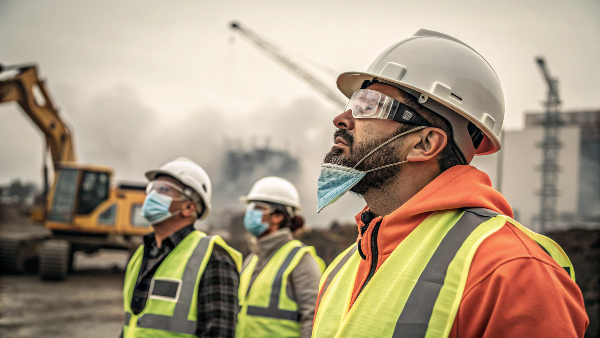
The point of wearing a reflective vest is very straightforward: to make sure other people can see you. It sounds simple, but it’s incredibly important. If a driver or a machine operator doesn't see you, they can't take action to avoid hitting you. I've been in this business with Vissafety since 2007, and this basic principle has never changed.
| Key Function | Description | Importance |
|---|---|---|
| Increase Conspicuity | Make the wearer stand out from their background. | Critical for being noticed by others. |
| Proactive Safety | Taking a step to protect oneself, not relying solely on others. | Empowers the wearer in hazardous situations. |
| Warning Signal | Acts as a bright, visual alert to those nearby, especially operators. | Helps prevent collisions and accidents. |
| Universal Need | Addresses a basic safety requirement in many work/recreational settings. | Broad applicability across many scenarios. |
The technology of the reflective materials gets better, and the designs of the vests become more comfortable and stylish. But the fundamental reason for wearing one stays the same: to make a person stand out from whatever is behind them. It's a proactive safety measure. This means you are taking a step to protect yourself, instead of just relying on other people to be careful. This is so important in places where there are lots of distractions, or where the lighting is poor. The vest works like a bright warning signal that tells everyone, "I am here." That's the whole point, and it’s a point that can save a life.
When should you wear a reflective vest?
Are you unsure about the exact right time or situation to put on a reflective vest? Guessing about this can lead to very dangerous situations where you are not seen. Specific conditions demand their use.
You should wear a reflective vest whenever working in low light (dawn, dusk, night), bad weather (rain, fog, snow), near moving traffic or machinery, or when safety regulations require it.
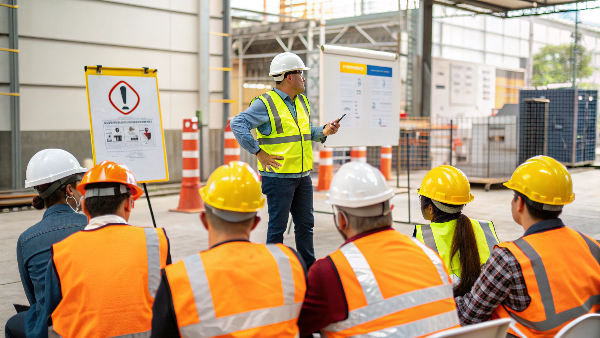
Knowing when to wear a reflective vest is just as important as having one. It's not enough to just own a vest; you need to use it at the right times. As a manufacturer at Vissafety, we always advise our clients to think about several situations.
| Condition | Why a Vest is Crucial | Examples |
|---|---|---|
| Low Light Conditions | Dawn, dusk, night; reduced natural illumination. | Night shifts, early morning starts |
| Adverse Weather | Rain, fog, snow, mist; visibility significantly impaired. | Working outdoors during storms or heavy fog |
| Proximity to Traffic | Working on or near roads, highways, or vehicle pathways. | Road construction, accident response |
| Near Moving Machinery | Construction sites, warehouses, factories. | Operating or working around forklifts, cranes |
| Regulatory Requirements | Mandated by workplace safety laws or company policies. | Specific job sites, industries |
Working at night is an obvious time. But dawn and dusk are also very high-risk periods. During these times, the light is changing, and it can be hard for drivers to see pedestrians or workers. Bad weather conditions are another key time. Fog, heavy rain, or snow can greatly reduce how far you can see. A reflective vest helps cut through that poor visibility. Any time you are working near moving vehicles or machinery, you should wear one. This includes working on roadsides, in construction sites, or in warehouses where forklifts are moving around. Often, company safety rules or government regulations will tell you when you must wear one. It's always better to be safe than sorry. If you have any doubt about whether you are visible enough, put on the vest. It’s a small thing to do that can prevent a big accident.
Why do people wear reflectors?
What's the actual science behind those shiny strips on safety vests and clothing? Not understanding how they work might mean you don't realize how important they are. Reflectors use light to save lives.
People wear reflectors, like those on safety vests, because they bounce light directly back to its source (e.g., car headlights). This makes the wearer appear very bright and highly visible in the dark.

People wear reflectors because of the special way they handle light. The key idea is "retro-reflection." Think about a normal surface, like a wall. When light hits it, the light scatters in many directions. This is called diffuse reflection. A mirror reflects light too, but it bounces off at an angle. Retro-reflective materials are different.
| Type of Reflection | Light Path After Hitting Surface | Visibility Outcome for Observer at Light Source |
|---|---|---|
| Diffuse Reflection | Scatters in many directions | Surface appears dimly lit, low contrast |
| Mirror Reflection | Bounces off at an angle (angle of incidence = angle of reflection) | Light directed away unless observer is at precise angle |
| Retro-reflection | Bounces directly back to the source | Surface appears very bright, high contrast |
They are designed to send light rays directly back to where they came from. So, if light from a car's headlights hits a reflector on your vest, that light goes straight back to the car. This makes the reflector look very bright to the driver. It doesn't create its own light; it uses the light from other sources. This is why reflectors are so important for night-time visibility. At Vissafety, our R&D lab has many testing devices to make sure our reflective materials meet global standards like EN ISO 20471 and ANSI/ISEA 107. We test how strong the reflection is because we know that the brightness of that shine is what helps drivers see someone in the dark and gives them more time to react. It’s science working to keep people safe.
What is the purpose of retro reflective patches on life jackets?
Life jackets are designed to save you if you fall into the water. But what about being found by rescuers? Being lost at sea, especially at night or in bad weather, is a terrifying thought. Reflective patches are vital for rescue.
Retro-reflective patches on life jackets make a person in the water highly visible to searchlights from rescue teams (boats, helicopters) during nighttime or low-visibility search and rescue operations.
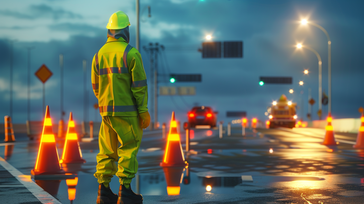
The purpose of retro-reflective patches on life jackets is all about being found. While Vissafety mainly produces high-visibility clothing for workers on land, the science of retro-reflection is just as vital at sea. Imagine someone falls overboard from a boat. Especially at night, or in stormy weather with big waves, that person can be very hard to see.
| Feature | Situation | Outcome for Rescue |
|---|---|---|
| Retro-reflective Patches | Person overboard, especially at night/low vis. | Enhances visibility to searchlights. |
| SOLAS Grade Tape | Harsh marine environment, saltwater exposure. | Durable, maintains high reflectivity. |
| Searchlight Interaction | Rescue teams scanning water surface. | Patches create bright "beacon" return to light source. |
| Overall Purpose | Lost at sea scenario. | Increases chance of being spotted quickly, aiding survival. |
Rescue teams in boats or helicopters use powerful searchlights to look for them. Without reflective patches, it's very difficult for the searchlights to pick out a person. But if the life jacket has retro-reflective patches, these patches will shine very brightly when the searchlight beam hits them. This bright reflection acts like a beacon, guiding the rescuers to the person's location. The materials used for these patches, often called SOLAS tape (Safety of Life at Sea), are very durable. They have to withstand salt water and harsh conditions while still reflecting light powerfully. It’s all about increasing the chances of being spotted quickly. The faster someone is found in the water, the better their chance of survival.
For which tasks should you wear a reflective vest?
Are you unsure if your specific job task or activity actually requires wearing a reflective vest? This kind of uncertainty can put your safety, or the safety of your team, at risk. Many tasks inherently need enhanced visibility.
Wear a reflective vest for tasks involving working near traffic (like roadwork or crossing guiding), operating or working near heavy machinery, any construction work, emergency response, and any work in low-light or poor visibility.

This question helps us think about specific jobs where a reflective vest is essential. At Vissafety, we often talk with our clients about the exact tasks their workers do. This helps us recommend the best type of high-visibility clothing. For example, if the task is road construction or repair, workers are right next to moving cars and trucks.
| Task/Profession | Key Hazard Addressed by Vest | Typical Visibility Standard often Needed |
|---|---|---|
| Road Construction/Repair | Proximity to fast-moving traffic. | ANSI Class 2 or 3 |
| Warehouse Operations | Interaction with forklifts, limited sightlines. | ANSI Class 2 |
| Emergency Response | Chaotic scenes, low light, multiple moving vehicles. | ANSI Class 2 or Public Safety Vest |
| Airport Ground Crew | Working around large aircraft, service vehicles, night ops. | Often specific airport/airline standards |
| Utility Work (Roadside) | Exposure to traffic while focused on repair tasks. | ANSI Class 2 or 3 |
| School Crossing Guard | Ensuring visibility to drivers in busy school zones. | Bright colors, often with reflective tape |
In this case, a high-visibility vest that meets a standard like ANSI Class 2 or Class 3 is absolutely necessary. If the task is working in a warehouse with forklifts, a vest helps the forklift operators see the workers, even if their view is partly blocked. Emergency responders at an accident scene must wear them. These scenes are often dangerous, with lots of activity and sometimes poor lighting. Other tasks include surveyors, event staff, and more. The basic rule is this: if the task means you might not be easily seen by someone driving a vehicle or operating machinery, or if the light is low, you should wear a reflective vest. It's about looking at the risks of each task and using a simple, effective tool to reduce those risks.
Conclusion
Reflective vests are essential PPE. They greatly boost your visibility to others. This helps prevent serious accidents and ultimately saves lives. Always prioritize wearing one when visibility is important.
-
Explore the benefits of reflective vests to understand how they enhance safety in various environments, especially for workers. ↩
-
Learn about the critical role of visibility in safety, particularly in low light, to appreciate the importance of reflective gear. ↩
-
Discover the technology behind retro-reflective tape and its effectiveness in enhancing visibility at night, crucial for safety. ↩
-
Explore the advantages of reflective jackets, including visibility, weather protection, and comfort for outdoor workers. ↩
-
This resource will provide insights into the critical role of reflective vests in protecting construction workers from accidents and injuries. ↩
-
Learn how reflective vests are essential for emergency responders, improving their visibility and safety in chaotic situations. ↩

